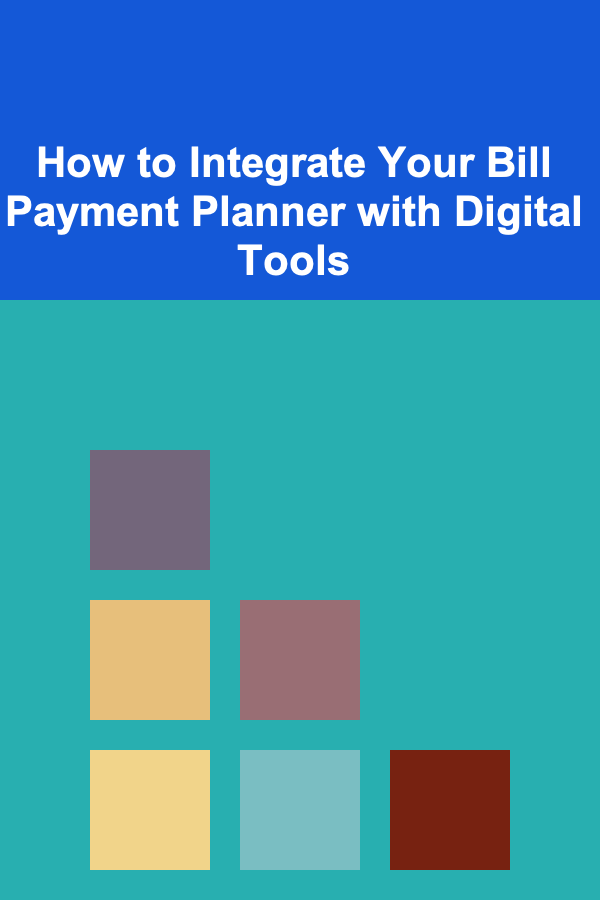
How to Integrate Your Bill Payment Planner with Digital Tools
ebook include PDF & Audio bundle (Micro Guide)
$12.99$5.99
Limited Time Offer! Order within the next:

In today's fast-paced world, managing finances effectively has become more important than ever. With various bills to pay, deadlines to meet, and financial responsibilities to juggle, keeping track of payments can be a daunting task. However, integrating your bill payment planner with digital tools can help streamline the process, making it easier to stay on top of your payments and avoid late fees. In this article, we will discuss the benefits of using digital tools for bill payment planning, how to integrate them with your existing planner, and provide some tips on managing your finances more effectively.
Understanding the Importance of Bill Payment Planning
Before we dive into the digital tools and integration process, it's important to understand the significance of having a bill payment plan in place. A bill payment planner is a system that helps individuals keep track of their financial obligations, ensuring that payments are made on time and in full.
Benefits of Bill Payment Planning:
- Avoiding Late Fees: By staying organized and making timely payments, you can avoid costly late fees that can add up over time.
- Maintaining a Good Credit Score: Timely bill payments can have a positive impact on your credit score, making it easier to secure loans and credit in the future.
- Reducing Financial Stress: Having a clear picture of your upcoming payments and financial obligations can help reduce anxiety and stress related to managing your finances.
- Building a Savings Plan: By planning ahead, you can allocate funds towards savings or investments, improving your financial future.
With these benefits in mind, integrating a bill payment planner with digital tools can enhance your financial management, providing real-time tracking, automation, and reminders that can make the process much smoother.
Choosing the Right Digital Tools for Bill Payment Planning
There are various digital tools available that can help you manage your bill payments. These tools range from simple calendar apps to more advanced financial management platforms. The key is to choose the tools that best fit your needs, taking into account your financial goals, the number of bills you need to track, and the level of automation you want.
Types of Digital Tools for Bill Payment Planning
- Calendar Apps: Simple calendar apps like Google Calendar or Apple Calendar can be an easy way to schedule bill payments. You can set recurring events to remind you of upcoming payments and due dates.
- Budgeting and Finance Apps: Tools like Mint, YNAB (You Need A Budget), or EveryDollar help you track all of your financial transactions, categorize them, and set reminders for bill payments. These apps can also give you insights into your spending patterns, helping you plan for future payments more effectively.
- Banking Apps: Many modern banking apps offer bill payment features that allow you to schedule and pay bills directly from your account. Some apps even let you set up automatic bill payments for recurring expenses like utilities or subscriptions.
- Dedicated Bill Payment Platforms : Platforms such as Prism or Bill.com specialize in helping users manage their bill payments. These services provide centralized access to all of your bills, send payment reminders, and even allow you to pay multiple bills from one place.
Key Features to Look For
When choosing a digital tool to integrate with your bill payment planner, consider the following features:
- Automatic Bill Payment: The ability to automatically schedule and pay bills ensures that you never miss a payment.
- Reminder Notifications: Alerts and notifications about upcoming payments can help you stay on top of your obligations.
- Expense Categorization: Categorizing your bills can help you see where your money is going and make it easier to track your financial goals.
- Multiple Payment Methods: Make sure the tool allows you to pay via multiple methods, such as credit cards, bank transfers, or mobile payments.
How to Integrate Your Bill Payment Planner with Digital Tools
Once you have selected the digital tools that best fit your needs, the next step is to integrate them into your existing bill payment planner. Integration can involve connecting your planner to the tools, syncing data across platforms, or using automation to streamline the process.
Step 1: Syncing Your Bill Payment Planner with Calendar Apps
If you're using a simple calendar app to manage your bill payments, the first step is to input your bills into the calendar. Most calendar apps allow you to create recurring events for bills that repeat monthly, quarterly, or annually.
- Set Up Recurring Events: For bills like rent, utilities, and subscriptions, create recurring events with the payment date and due amount. Include any additional details, such as the payment method or account information.
- Enable Notifications: Set notifications to remind you of the payment date well in advance. This can help ensure that you have enough funds available when the payment is due.
- Link Payment Methods: While calendar apps don't offer direct payment integration, you can link them to your banking or payment apps for easy access when it's time to pay your bills.
Step 2: Integrating with Budgeting and Finance Apps
If you prefer more advanced tracking and budgeting tools, apps like Mint or YNAB can be integrated with your bill payment planner. These apps allow you to track your expenses, set savings goals, and monitor upcoming bills all in one place.
- Link Bank Accounts: Connect your bank accounts, credit cards, and any other relevant financial accounts to the app. This will automatically pull in your transaction data and categorize your bills.
- Set Up Bill Reminders: In addition to tracking expenses, these apps allow you to set reminders for bill payments. You can also categorize your bills (e.g., utilities, subscriptions, etc.) to track how much you're spending in each area.
- Automate Bill Payments: Some budgeting apps offer features that enable you to schedule automatic payments for recurring bills. This ensures that your bills are paid on time without you having to manually make payments each month.
Step 3: Using Banking Apps for Bill Payments
Most modern banking apps allow you to schedule bill payments directly from your bank account. If your bank supports this feature, you can set up automatic bill payments for regular expenses.
- Link Your Bills to Your Bank Account: For recurring bills like utilities, mortgages, or subscriptions, link the biller to your bank account. This will allow you to set up automatic payments.
- Track Payment History: Banking apps typically allow you to track your payment history and see when each bill was paid. This can help you ensure that all of your bills are up-to-date and accounted for.
- Use Payment Alerts: Set up notifications to alert you when a bill is due or when a payment has been successfully processed. This gives you an added layer of assurance that your payments are being made on time.
Step 4: Leveraging Bill Payment Platforms
If you are looking for a more centralized approach, bill payment platforms like Prism or Bill.com can help you manage all of your bills in one place.
- Link Your Accounts: These platforms allow you to link your utility companies, lenders, and other billers. Once linked, you can view your upcoming bills in one dashboard and make payments directly from the platform.
- Automate Bill Payments: Set up automatic payments for recurring bills, so you don't have to worry about missing any payments. These platforms will also send you reminders for one-time or irregular bills.
- Track Payment Status: These tools often provide real-time updates on the status of your bills, so you can track whether they have been paid, are pending, or are overdue.
Best Practices for Managing Your Bill Payments
Once you have integrated your bill payment planner with digital tools, it's important to establish a routine and set best practices to stay on top of your payments.
1. Review Your Bills Regularly
Make it a habit to review your upcoming bills each month. By doing this, you can spot any discrepancies, overcharges, or errors early and take corrective action.
2. Set Aside Funds for Bills
Ensure that you have enough funds in your bank account to cover your bills. You can set up a separate savings account specifically for bills or keep a buffer in your main account to avoid any overdrafts.
3. Use Automation Wisely
Automate as many payments as possible to avoid missing deadlines. However, keep track of the payments to ensure everything is processed correctly. Occasionally check your automated payments to ensure they are still set up correctly.
4. Stay Organized with Categories
Use categories to organize your bills by type (e.g., utilities, subscriptions, loans). This makes it easier to track your spending and see where you can make adjustments to your budget.
Conclusion
Integrating your bill payment planner with digital tools can help you take control of your finances, streamline the payment process, and avoid late fees. By choosing the right tools and implementing best practices, you can ensure that your bills are paid on time, reduce financial stress, and improve your overall financial health. With technology on your side, bill payment planning becomes not just a task but a powerful tool for better financial management.
Reading More From Our Other Websites
- [Home Pet Care 101] How to Select the Best Pet Toys for Cats: Encouraging Play and Preventing Destructive Behavior
- [Organization Tip 101] How to Update Your Staircase with Stylish and Durable Treads
- [Organization Tip 101] How to Provide Feedback Effectively in Virtual Teams
- [Home Space Saving 101] How to Maximize Storage in Your Bedroom Without Taking Up Space
- [Home Cleaning 101] How to Clean a Microwave: Tricks for Removing Grease and Odors
- [Star Gazing Tip 101] Essential Gear and Tips for Star Gazing Club Meetups
- [Home Staging 101] How to Furnish a Vacant Home: Practical Steps for Staging with Rental Furniture in Empty Properties
- [Home Rental Property 101] How to Use Insurance to Protect Your Rental Property
- [Home Budget Decorating 101] How to Use Thrifted Finds to Create a Unique Home Design
- [Paragliding Tip 101] Seasonal Wind Trends: Planning the Perfect Paragliding Day All Year Round

How to Brighten a Small Space with Strategic Lighting
Read More
How to Handle Rental Property Taxes and Reporting
Read More
How to Sell Your Artwork on Instagram: An Actionable Guide
Read More
How to Soundproof Your Home for Better Audio and Video Quality
Read More
How To Build a Strong Work Ethic
Read More
10 Tips for Real Estate Agents to Build a Strong Online Presence
Read MoreOther Products

How to Brighten a Small Space with Strategic Lighting
Read More
How to Handle Rental Property Taxes and Reporting
Read More
How to Sell Your Artwork on Instagram: An Actionable Guide
Read More
How to Soundproof Your Home for Better Audio and Video Quality
Read More
How To Build a Strong Work Ethic
Read More